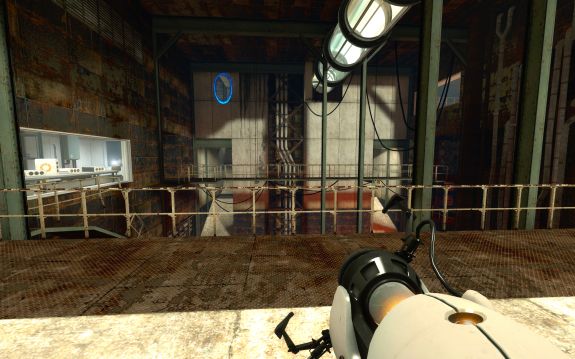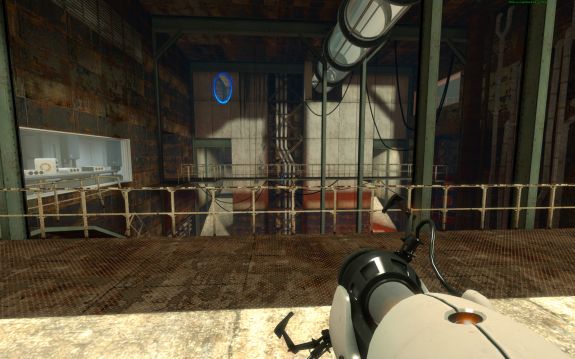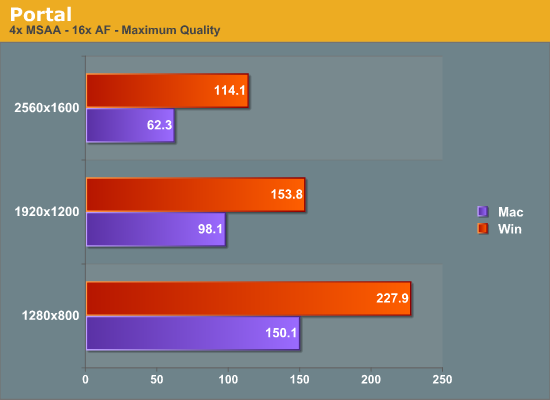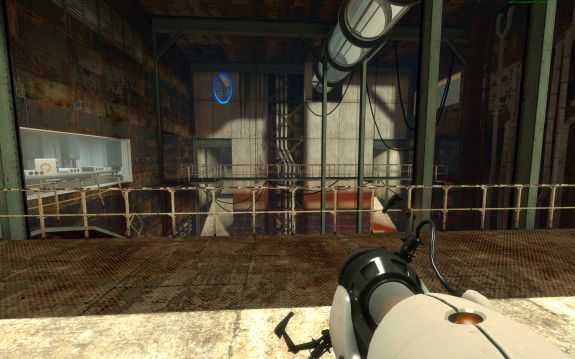Update 5/15/2010: Valve released a new patch for Portal on the 13th which resolved the blurriness issue. Please see our update below for for the full details.
It’s been a while since anyone treated Mac OS X as a first-tier gaming platform, so when Valve announced that they would be bringing their Steam service and the Source engine to the Mac, it was big news. After a roughly 2 month beta period for the Mac versions of Steam and the Source engine, yesterday Valve finally released the first wave of their Mac gaming efforts.
As it stands Valve is taking a gradual approach to rolling out their back catalog to the platform. Even though Steam is out and the Source engine has been ported, this week has seen the release of only 1 Source game for the Mac: 2007’s critically acclaimed Portal.
While it’s not the most graphically intensive Source game these days (that title belonging to Left 4 Dead), at this point it’s as good as anything else for looking at the performance of the Source engine under Mac OS X, particularly considering how long it’s been since a game’s original developer did the Mac port. So with that in mind, we went ahead and took a quick look at Portal’s performance under Mac OS X.
As is the case with all of the games on the Source engine, they’re designed to scale up and down fairly well. With modern hardware though, we’re hard-pressed to keep older Source games from achieving runaway frame rates. So Portal performance is somewhat arbitrary – most Macs with a discrete GPU should be able to handle it to an acceptable degree.
The Test
For our test we loaded up our GPU test rig with Mac OS X 10.6.3 in a Hackintosh configuration. As Mac OS X does not currently support either the GeForce GTX 400 series or the Radeon HD 5000 series, we had to step back a bit with our video card choice, settling for a GeForce GTX 285. And while the use of a Hackintosh does technically invalidate our results since it’s not a real Macintosh, based on our experiments we believe that our results don’t suffer in any way for using a Hackintosh, and as such we believe the results to be experimentally valid. But of course, your mileage may vary.
| CPU: | Intel Core i7-920 @ 3.33GHz |
| Motherboard: | Intel DX58SO (Intel X58) |
| Chipset Drivers: | Intel 9.1.1.1015 (Intel) |
| Hard Disk: | OCZ Summit (120GB) |
| Memory: | Patriot Viper DDR3-1333 3 x 2GB (7-7-7-20) |
| Video Cards: | NVIDIA GeForce GTX 285 |
| Video Drivers: | NVIDIA ForceWare 197.13 |
| OS: |
Windows 7 Ultimate 64-bit Mac OS X 10.6.3 "Snow Leopard" |
Image Quality
We’ll start quickly with a look at image quality. Valve is traditionally a staunch Microsoft ally, having built up their services and engines around Windows and DirectX. For the Mac OS X port of Source, Valve had to replace the DirectX backend of Source with Mac-appropriate components, the key of which is OpenGL. Such a change can impact image quality depending on how it’s done.

Portal - Windows. Click to enlarge

Portal - Mac OS X. Click to enlarge.
We have a gallery of screenshots, but for our analysis we’ll stick with comparing in a single set. Going with 2560x1600 with the game at its highest settings and 4xAA/16xAF, to our surprise the images are distinctly different when directly compared. The Mac screenshot is noticeably foggier than the Windows image, and textures appear to be less sharp. It’s not a night & day difference, but the Windows screenshot is distinctly clearer than the Mac screenshot. Without a Windows reference image it would be harder to tell that the Mac screenshot differs this much, but we believe that the difference is great enough that anyone with an eye for details that has ever played Portal on Windows would notice the foggier/blurrier IQ on the Mac.
Now some of this can be explained away due to gamma, since Mac OS X and Windows have different default gamma levels, but gamma could never explain the entire difference. There’s clearly a difference in IQ between the Windows and Mac OS X versions of Portal, and it’s not in the Mac’s favor. It’s by no means bad, but as one person put this when being shown these screenshots “It’s like looking at a magazine scan” when looking at the Mac.
Performance
The other half of our quick look is at performance. The Macintosh platform is renowned for being a graphical powerhouse, but this refers to professional/prosumer photography and the like. For gaming, Apple has been slow to include support for new hardware and new driver features (they are just now OpenGL 3.0 compliant) and overall their drivers are more conservative when it comes to performance. Portal is going to be slower, the question is by how much.

We went ahead and ran a timedemo from test chamber 18 and beyond on both the Mac OS X and Windows versions of Portal. We kept the settings cranked up at all times, but varied the resolution between 1280x800 and 2560x1600 to look at different GPU loads. At the worst-case of 2560, the Mac version of Portal runs at only 54% of the speed of the Windows version. That moves to 63% at 1920x1200, and 66% at 1280x800.
Portal – like all Source engine games – is CPU limited when given a powerful enough GPU, and even with just a GTX 285 we can approach that under Windows. Under Mac OS X however, we look to be GPU limited at all times. The framerate never suffers as we’re always averaging more than 60fps, but we can easily turn off MSAA and AF to improve performance if we needed to.
Closing Thoughts
For Source engine enthusaists hoping to see the Mac OS X port of the Source engine meet the high standards of the Windows version, Portal presents a mixed bag. In our limited testing the Mac version of Portal doesn’t significantly suffer for being a port, but at the same time it can’t quite match the image quality of the Windows version. Feature-for-feature there is parity, but the Mac version just isn’t as sharp as the Windows version.
Performance isn’t any better. Portal is an easy game to run and so we’re largely being academic here, but the “tax” for Mac OS X is roughly a generation in hardware performance. For the performance we’re seeing on a GTX 285 under Mac OS X the results are similar to what we’d see under Windows with something like a 9800GTX. Given that at the high-end the Mac platform is also a generation behind in hardware, and you’re looking at 2008 performance for Portal even with the best hardware you can get today for a Mac.
Ultimately having the Source engine ported to Mac OS X is going to remove the technical need to use Bootcamp to run Windows for games, but based on Portal it doesn’t remove the need to boot Windows for performance reasons. For long-time Mac users none of this should be surprising, but it means that we shouldn’t expect the Mac OS X version of the Source engine to be revolutionary.
Update: 5/15/2010
On Thursday after we published our article Valve pushed out an update for Portal that focused on fixes for the Mac version. The big fix was the following:
Fixed screen "fuzziness" caused by color correction operation
This fixed the blurriness issue we saw with the initial version of Portal. Texture and geometry quality is now as sharp as it is under Windows. Performance remains unchanged, while there is still an image quality difference between the two due to lighting differences and a general degree of fogginess that still appears on the Mac OS X version.























178 Comments
View All Comments
Penti - Sunday, May 16, 2010 - link
Last time I checked id Tech 5 or the Rage engine is still OpenGL with a DX9 equivalent code path for Xbox 360.95% of the OpenGL 3.0 features are included in the ATI drivers, both nVidia and ATi drivers fully supports OpenGL 2.1 with any card newer then X1600/X1900 which is more then the consoles do, you have Cg support on OS X, Cuda, and OpenCL on top of ARB, GLSL and other shading based techniques which build on that. The vendors are fully freely to release their own implementations, implement things faster, or even faster then Apple and fully free to release their own drivers, they don't need to be signed or anything the GTX 285 is for example and example of a aftermarket card which for they released their own drivers straight from nVidias web site and together with the card without waiting for a system update to support it, CUDA is another example of a features fully released outside and working outside of Apples channels. Elementals video encoding is another. The card was released by EVGA with them supporting it. Every card dedicated card from HD2400/7300+ or integrated nVidia supports OpenGL 2.1 fully and GLSL1.2 in OS X 10.6.3, and they all support GLSL1.2 back to 10.4.11 with discrete cards, at most they need to fall back to Open GL 2.0 which is roughly what the PS3 uses, and it surpasses or is equivalent to DX9 and Xbox 360's APIs. Of course if they really want to ATI and Nvidia can release updated drivers for 10.5.8 for better performance or even to implement some of the features which might help the performance. The game don't support anything lower anyway. Steam is a DX9 engine anyway it doesn't need anything more then OGL 2.0 which is equivalent to do all the same things. The console ports won't be more advanced then DX9 / OGL2 class any way.
None optimized drivers would be a problem though even if they would use a DX API instead, but we can expect Apple, Nvidia and ATI to continue work with that together with Valve and others. It has already happened in so many ways. But there's no problem to acquire the drivers outside of apples system update channels, if nvidia and ATI wants to provide them. Suggesting anything else is just disingenuous. Cards like FX 4800 or GTX 285 wouldn't be supported when hardware was released, if they couldn't extend features, CUDA and Elementals wouldn't be supported. But they all where.
Game studios develops their own tools mostly and with Cg etc available and the ability to port the tools, it's pretty good if they want it to be. You don't need to rewrite all your shader code if it's already in Cg and it can be used on most platforms. So the tools is there. You can convert HLSL shader code to GLSL by machine and so on. Reimplementing the rendering stage is what you do for the console builds any way. It's not worse then that. You use the same maps, models, data, textures etc. It's not that much different. Of course game code is not dependent on the underlaying rendering API's it's different things and game engines are already abstracted and somewhat multi-platform and porting SDKs and level editors is doable. Of course being the first to support OpenCL you can't say that they are that much behind when they are actually driving that process. And OpenCL and OpenGL go hand in hand together. The problem there is that they are so much further along then the consoles which will get updated APIs first when the next gen consoles arrive in a good couple of years. If they want too they could probably be a platform for developing those next gen games by then. Depending where Sony and others wants to put their resources. It's not like nothing will happen. Next gen engines like Rage/id Tech 5 will get mac builds too. Not just old ones. It's not really bleak it's a great platform if you build the tools there. Instead of just relying on third party ports and not moving the development environment and tools there.
Setsunayaki - Friday, May 14, 2010 - link
I am just trying to help out for consistency.Remember how it was stated that the image quality was worse on MAC OS X? For the purposes of Experimentation, since the image quality is lower, it also means that it takes less effort to produce the image itself. The OS X version of Steam/Source obviously has certain elements it can not duplicate well along with the video drivers.
The windows version gets its framerate under full Quality on how the image should appear. The blurriness in the MAC version asks for certain questions:
1) As MACs tend to be built for image quality in professional photography along with their monitors....it begs to ask on what is the source of the blurriness.
Is it just the video driver itself or the implementation of Steam/Source Engine?
2) How does the Slowdown of the game and its framerate on a video card affect the wear on the video card? Obviously if both cards on both machines are trying to work just as hard, but limited by what the engine and driver can bring to the table, then Obviously you are going to see similar temperatures...
3) Have you looked at any situations in which sections of the rendering by accident use more of the libraries linked to software Rendering in Conjuction with OpenGL and tested such intensity or severity?
Im asking these questions because now that Steam exists on MAC OS X and the Operating System is something completely different and being a derivative of unix/linux that has been heavily modified and changed....That one game really is your gateway to a series of rendering tests...The kind of tests that Nvidia could use to make better drivers..
You might as well test the hell out of the platform in every possible conceivable method. I am sure you will find something interesting. ^_^...I wonder if I should handle all the testing on my end as I have a lot of different OSes here I like to test out along with enough time to do it.
Well, Good Luck and thanks for the Article
B3an - Saturday, May 15, 2010 - link
"1) As MACs tend to be built for image quality in professional photography along with their monitors....it begs to ask on what is the source of the blurriness."...What? people still think this? Macs are not magically better for image quality. Macs being better for photography and design is an old myth that needs to die already.
ALL components in Macs these days are just PC components. No difference at all. You can also buy better monitors than what apple sells. They will cost more as they are truly high-end professional displays, but the money you save from getting a PC will make the overall cost (PC + Pro monitor) be about the same as getting an inferior Mac system.
B3an - Saturday, May 15, 2010 - link
By the way the "fuzziness" issue on the Mac seems to have been fixed with an update. But it will never look any better on a Mac than on a PC with a good IPS monitor as mentioned above.star-affinity - Saturday, May 15, 2010 - link
Maybe you should stop saying ”will never happen” when you can't be sure. :Pstar-affinity - Saturday, May 15, 2010 - link
Maybe he's not talking about the hardware, but the software?robco - Saturday, May 15, 2010 - link
I have the last gen MacBook Pro (2.66GHz, 9600M GT, 256) and Portal runs fine at 1440x900. I can't say if it's as fast as Windows, but the image quality is good. I can't use the ~ to bring up the console and get the fps, but I never experienced any issues. I imagine an iMac would handle it just fine. Even looking at the benchmarks from the article, the performance on the Mac isn't as fast as it is on WIndows, but it's not completely unacceptable either.As for the Mac, it's interesting that every Mac that now ships has at least a somewhat capable GPU. Can't say the same for all Windows boxes. As for why I chose it and paid more, the MBP is still one of the thinnest and lightest fully featured laptops available. It's incredibly sturdy. The LED backlit display is great, as is the backlit keyboard. Battery life isn't an exaggeration, it's great. Little touches like MagSafe are icing on the cake. I considered Lenovo and Dell, but by the time I added the features I wanted, the price difference started to shrink. You only have to check this site for positive reviews of Apple's laptops.
My gaming needs are minor, it's not my primary use for my computer. I wanted something that would run WoW and SC2 and it does. For gamers, a Windows PC is always the better choice. But the Mac has plenty of things going for it, especially when it comes to laptops.
botrytis - Saturday, May 15, 2010 - link
Yes - your battery life is great because your system IS NOT using your high-powered GPU. It is using the Intel on-borad video. Also your CPU is trottled down quite a bit by the Apple OS. If you trottle up your OS and switch to your high powered GPU - your battery life will be the same as PC clone.OS X looks nice but the underpinningsare 2 generations old. If Apple wanted to be so up to date, then they should update the underpinnings and OS just like MS does.
robco - Saturday, May 15, 2010 - link
Where to begin... Mine doesn't have an Intel integrated GPU, the new ones do. I get over 5 hours with the 9600, over 6 easily with the 9400. The C2D throttles itself back when needed. The larger, built-in battery is part of the reason for the better battery life, it's also a smarter battery. OS X is also much better at power management than Windows, this is a good thing.As for the underpinnings, Apple is relatively current wrt BSD. They've released several OS updates in the eternity it took MS to release WIndows Vista (still on the NT 5 kernel btw and that's with many features tossed out to make the ship date and even then few people upgraded) and now finally Windows 7. Even WIn 7 is missing a few features (WinFS anyone?).
mojohacker2010 - Sunday, May 16, 2010 - link
I have a similar MBP and I know for a fact you don't get 5-6 hours of battery life. The older 9600 actually drains a lot more power. Apple doesn't somehow defy the law of physics and create more energy out of nowhere. It's fine to be loyal to a company but please don't spew ignorance or pull random numbers out of your ass.